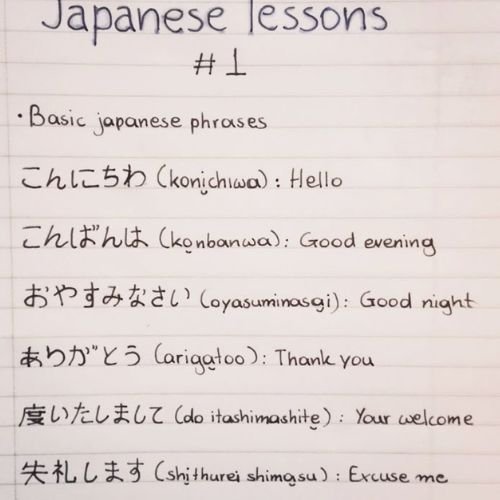Free Japanese Lessons for Beginners (Step-by-Step)
If you're just starting your journey to learn Japanese, you've landed in the right place. These Free Japanese Lessons for Beginners are designed to walk you through essential topics step-by-step — all the way from basic greetings to practical daily conversations. Whether you're preparing for travel, self-study, or simply passionate about Japanese culture, this beginner-friendly guide makes learning accessible, engaging, and structured.
Step-by-Step Free Japanese Lessons for Beginners
Start your Japanese learning journey with our Step-by-Step Free Japanese Lessons for Beginners. These easy-to-follow lessons cover essential topics like greetings, numbers, directions, time, and everyday conversations. Ideal for self-learners, each lesson is designed to build your confidence and help you speak Japanese naturally and effectively.
Lesson 1: Basic Japanese Greetings and Self-Introduction
Start with learning how to greet someone in Japanese. Greetings are fundamental to polite conversation and show respect.
- こんにちは (Konnichiwa) – Hello
- おはようございます (Ohayou gozaimasu) – Good morning
- はじめまして (Hajimemashite) – Nice to meet you
- わたしは [Your Name] です (Watashi wa [Name] desu) – I am [Your Name]
Practice introducing yourself in front of a mirror or with a language partner.

Lesson 2: Counting in Japanese (Numbers 1–1000)
Understanding numbers helps you with shopping, counting people, telling time, and more.
- 1–10: いち (1), に (2), さん (3), よん (4), ご (5), ろく (6), なな (7), はち (8), きゅう (9), じゅう (10)
- Multiples of 10 and beyond: にじゅう (20), さんびゃく (300), せん (1000)
Practice counting objects around you or try basic math problems in Japanese.
Lesson 3: Days of the Week, Months & Seasons
Learn how to talk about the calendar in Japanese — useful for planning, appointments, and conversations.
- 月曜日 (Getsuyoubi) – Monday, 火曜日 (Kayoubi) – Tuesday
- 一月 (Ichigatsu) – January, 二月 (Nigatsu) – February
- 春 (Haru) – Spring, 夏 (Natsu) – Summer, 秋 (Aki) – Autumn, 冬 (Fuyu) – Winter
Combine these to say dates: e.g., 今日は水曜日です (Today is Wednesday).
Read More-: Learn Japanese in 30 Days
Lesson 4: Asking for Directions in Japanese
Perfect for travelers and new residents in Japan. Use these phrases when navigating a city:
- どこですか? (Doko desu ka?) – Where is it?
- 駅はどこですか? (Eki wa doko desu ka?) – Where is the station?
- 右 (Migi) – Right, 左 (Hidari) – Left, まっすぐ (Massugu) – Straight
Try creating mini-dialogues for practice.

Lesson 5: Ordering Food at a Restaurant
Enjoying Japanese cuisine starts with knowing how to order politely.
- メニューをください (Menyuu o kudasai) – Please give me the menu
- [Dish] をください – I’ll have [Dish], e.g., うどんをください (Udon, please)
- おいしい (Oishii) – Delicious
Practice this using restaurant menus or Japanese food videos.
Read More-: Japanese Proverbs
Lesson 6: Talking About Family & Friends
Family terms are often used in daily conversation and cultural context.
- はは (Haha) – My mother, ちち (Chichi) – My father
- ともだち (Tomodachi) – Friend
- かぞく (Kazoku) – Family
Create sentences like これは私のかぞくです (This is my family).
Lesson 7: Common Verbs and Sentence Structures
Learn verbs you’ll use every day and how to form simple sentences.
- たべます (Tabemasu) – To eat, のみます (Nomimasu) – To drink
- Verb + ます form is polite.
- Sentence structure: Subject + Object + Verb
- わたしはりんごをたべます – I eat an apple.
Study verbs with flashcards or in real-life scenarios.
Lesson 8: How to Tell Time in Japanese
Telling time is vital for daily conversations, travel, and scheduling.
- 今何時ですか? (Ima nanji desu ka?) – What time is it?
- 一時 (Ichiji) – 1 o’clock, 二時半 (Niji han) – 2:30
- 朝 (Asa) – Morning, 夜 (Yoru) – Night
Use a clock or your phone to ask and answer the time in Japanese.
Read More-: Learn Japanese Idioms and Proverbs

Why Free Japanese Lessons Are Perfect for Self-Learners
Learning Japanese doesn’t have to be expensive or intimidating. These lessons offer a flexible and practical approach that allows you to study at your own pace — wherever and whenever you choose. Whether you're using digital flashcards, PDF worksheets, or watching YouTube tutorials, the key is to stay consistent and start with the basics.
With this guide, you’ll move through step-by-step beginner lessons, each designed to cover useful, real-life communication. From greetings to ordering food and telling time, you’ll gradually build a strong foundation in grammar, vocabulary, and pronunciation — without feeling overwhelmed.
Practice Tips for Beginners
Consistent practice is key to mastering Japanese as a beginner. Start with daily repetition of vocabulary, speak aloud to improve pronunciation, and use flashcards or apps to reinforce what you learn. Watching anime or listening to Japanese music with subtitles can also make learning fun and effective. Keep it simple, steady, and stay motivated!
- Dedicate 30–60 minutes daily for review and practice
- Use apps like Duolingo, Tandem, or Anki for reinforcement
- Speak aloud, even when studying alone
- Watch Japanese shows or anime with subtitles for real usage
- Join a TLS-The Japanese Language School classes for better structure and support
Frequently Asked Questions (FAQs)
Q1: Is Minato Japanese free?
Yes, JF Japanese e-Learning Minato offers free and paid courses, especially for beginner-level learners.
Q2: How do I learn Japanese by myself?
Start with structured lessons like this one, use flashcards and free apps, and immerse yourself in Japanese media.
Q3: What is the best free program to learn Japanese?
Minato, Duolingo, and NHK World’s Easy Japanese are popular and effective for beginners.
Q4: Is 2 hours a day enough to learn Japanese?
Yes, 2 hours daily can lead to strong results over time—consistency and review are key.
Q5: Is Minato a boy or a girl?
Minato is actually the name of the platform ("港" meaning port) and not a person—it’s gender-neutral.
Conclusion: Begin Your Journey to Fluency with Confidence
Learning Japanese may seem challenging at first, but with the right guidance and consistent practice, anyone can achieve fluency. These Step-by-Step Free Japanese Lessons for Beginners are designed to help you build a solid foundation — from basic greetings to practical daily expressions. Whether you're studying on your own or preparing for future travel, every lesson brings you one step closer to understanding the language and culture of Japan.
Ready to take your learning further?
For expert guidance and structured Japanese training, visit TLS – The Japanese Language School in Delhi.
📍 2/81-82, 2nd Floor, Lalita Park, Gali No - 2, Laxmi Nagar, New Delhi - 110092
📞 +91 8700956038
📧 tls@teamlanguages.com
Start your Japanese learning journey the right way—with Free Japanese Lessons for Beginners and professional support from TLS!











